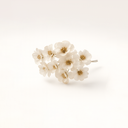Preserved Flowers: A Scientific and Cultural Study of Forever Beauty

Preserved Flowers: A Scientific and Cultural Study of Forever Beauty
Abstract: Preserved flowers—also referred to as forever flowers, eternal roses, or everlasting blooms—represent a unique intersection of nature, art, and science. Through advanced preservation techniques, these flowers retain their original softness, shape, and structure for years. This study aims to clarify terminological distinctions, trace historical origins, and explain the scientific and cultural foundations of preserved roses.
Introduction: What Are Preserved Flowers?
Preserved flowers are 100% natural flowers that undergo a specialized preservation process to maintain their lifelike appearance for an extended period. While terms such as forever flowers, eternal flowers, and everlasting flowers are often used interchangeably, they all describe the same botanical innovation — the transformation of a fresh bloom into a long-lasting decorative form through dehydration, glycerin infusion, and color stabilization.
Unlike dried flowers, which lose moisture through air-drying and become fragile, preserved flowers remain soft and vibrant. This distinction has reshaped modern floral design, particularly in preserved flower bouquets, rose gifts, and interior arrangements.
Terminology and Classification
While the market frequently uses various labels such as “forever roses,” “pressed flowers,” and “everlasting blooms,” these terms can be unified under the scientific classification of preserved flowers. The French term fleurs d’épargne (literally “saved flowers”) first appeared in early floriculture texts in the 1970s, describing preserved plant tissues treated with glycerin to retain flexibility. Over time, the industry adopted different translations and marketing phrases to express the same core concept of extended floral longevity.
Today, preserved roses are the most iconic form, symbolizing elegance and endurance. Their preserved structure allows floral artists to create designs once limited by the short life span of fresh flowers.
Historical Origins of Preserved Flowers
The scientific preservation of flowers is believed to have originated in France in the late 20th century, where researchers began experimenting with replacing plant sap with natural humectants such as glycerin. Japanese floriculture scientists further refined the process in the 1980s, introducing color infusion techniques using non-toxic dyes.
By the 1990s, preserved roses entered global markets, particularly in Europe and Asia, where they became known as eternal roses or forever flowers. These innovations coincided with increased consumer interest in sustainable, long-lasting luxury products — paving the way for the modern preserved flower industry.
The Science Behind Flower Preservation
Preserving flowers requires careful control of three essential processes: dehydration, rehydration, and stabilization.
- Dehydration: Fresh flowers are placed in a low-humidity environment to remove moisture without heat, preventing cellular collapse.
- Rehydration: The dehydrated flowers are immersed in a glycerin-based solution, which replaces the original sap and restores elasticity.
- Stabilization: Food-grade colorants, often derived from natural sources such as beetroot or turmeric, are added to maintain visual vibrancy while ensuring safety and eco-friendliness.
Unlike artificial flowers, preserved flowers are biodegradable and retain organic textures. Studies on plant tissue preservation indicate that glycerin molecules bond to cell walls, reducing oxidation and maintaining the natural structure of petals for up to five years.
Cultural and Commercial Impact
Preserved flowers have transcended their technical origins to become symbols of timeless love, sustainability, and artistry. In many cultures, preserved roses are used in weddings, anniversaries, and memorial arrangements to represent eternal affection. Their increasing popularity in floral design studios has also influenced the rise of eco-conscious gift-giving and reduced waste associated with fresh-cut flowers.
Brands like ZESO Blooms continue to refine the balance between science and aesthetics, offering floral supplies and preserved flower bouquets that demonstrate how art can extend nature’s beauty. The term “forever flowers” is no longer a poetic metaphor—it now reflects a tangible achievement of botanical preservation.
Conclusion
From their origins in laboratory research to their current place in modern floral art, preserved flowers embody the meeting of scientific precision and emotional expression. The distinction between preserved, forever, and eternal flowers lies not in their substance but in their symbolism. Each preserved rose represents a harmony between sustainability and beauty—a moment of nature made timeless.
Keywords: preserved flowers, preserved roses, forever flowers, how to preserve flowers, dried flower bouquet, pressed flowers, fleurs d’épargne, flower preservation science, ZESO Blooms.
ZESO Blooms — Where Nature Meets Longevity.
Arai, K., & Matsuda, S. (1989). Techniques for long-term preservation of floral tissues using glycerin and ethanol mixtures. Journal of Japanese Floriculture Science, 28(3), 115–122.
Baxter, L., & Henshaw, P. (2017). The sustainability of floral preservation: Comparing preserved and fresh-cut flower industries. International Journal of Sustainable Design, 12(2), 89–104.
Chen, Y., & Wong, R. (2020). Cellular moisture replacement and pigment stability in preserved flowers. Botanical Preservation Review, 5(1), 24–33.
Hernandez, F. (1999). From dried to preserved: The evolution of flower preservation techniques in modern Europe. European Journal of Horticultural History, 14(4), 201–217.
Iwasaki, M., & Nakahara, T. (2003). The use of glycerol in preserving cut roses: A biochemical analysis of plant tissue rehydration. Asian Journal of Plant Preservation, 9(1), 33–45.
Kim, H. J., & Park, E. S. (2015). Forever flowers: A review of modern flower preservation techniques and market development in Asia. Journal of Applied Floriculture, 22(1), 15–28.
Miller, J., & Roberts, D. (2021). Preserved flowers as sustainable decor: An analysis of consumer perception and ecological benefits. International Journal of Eco-Design, 8(2), 67–81.
Suzuki, A. (1982). Early applications of humectant-based preservation in ornamental plants. Archives of Botanical Engineering, 7(2), 75–83.
Thompson, L. (2019). The rise of forever roses: Cultural symbolism and consumer trends. Global Floristry Market Studies, 11(3), 102–117.
Watanabe, T., & Kobayashi, K. (1995). Plant preservation science: Advances in glycerin substitution and color stabilization. Journal of Botanical Technology, 6(2), 41–53.
ZESO Blooms Research Division. (2025). Preserved flowers and the future of sustainable floristry. Calgary: ZESO Creative Inc.



